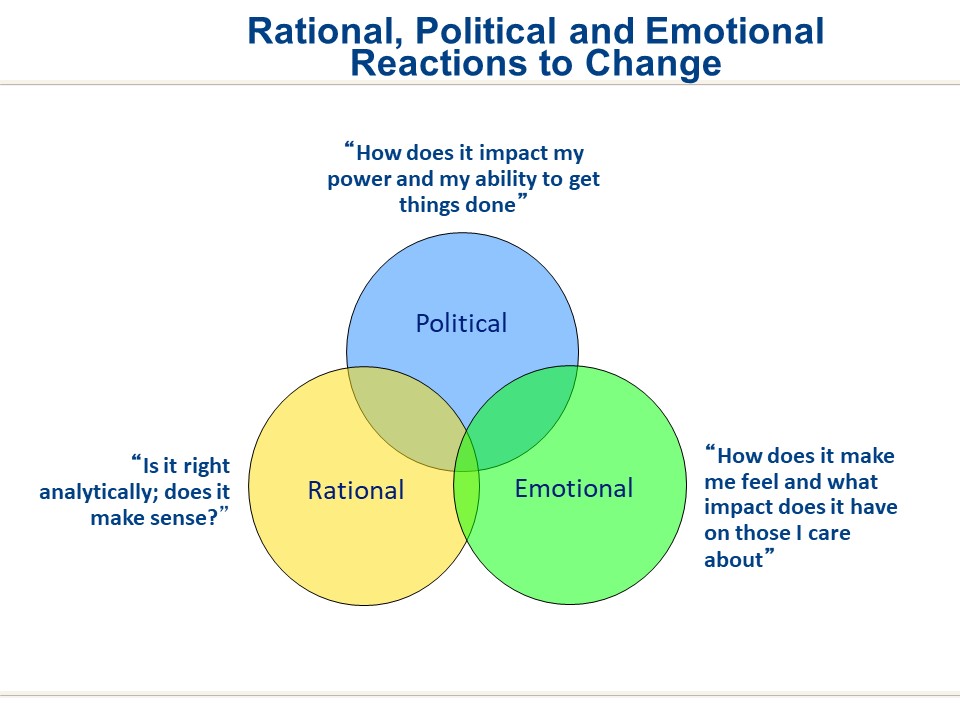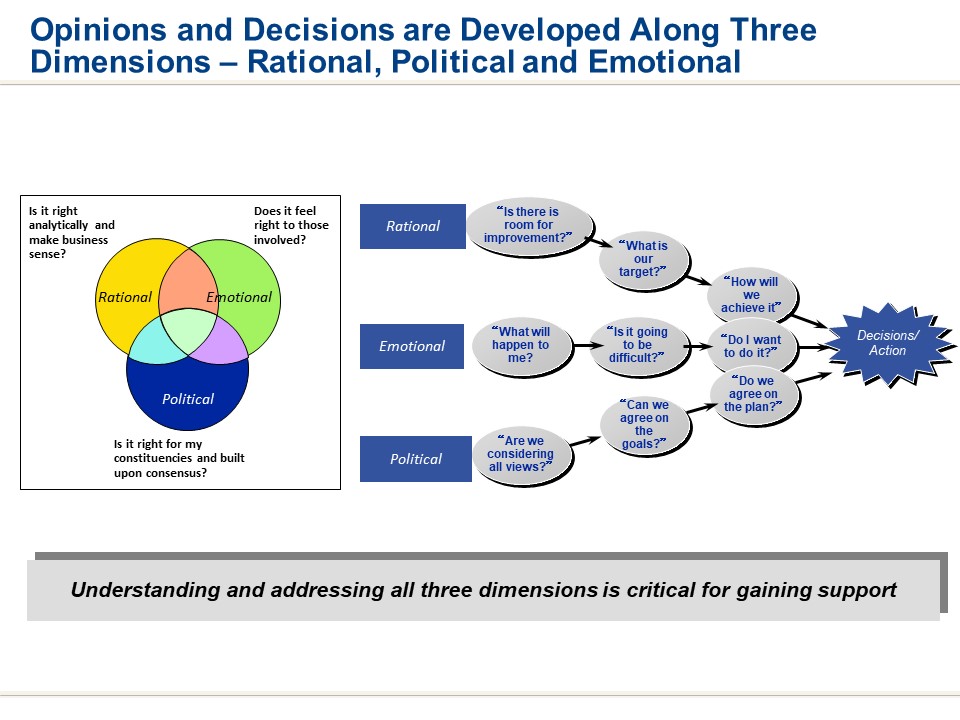“I’d like to think that people make decisions rationally, but it seems more complicated than that. What do I need to know?”
When I joined Gemini Consulting in 1995 (now Capgemini) I learned tons of tools and strategies to enable transformational change. One of the many I still use repeatedly is the model of the Rational, Political and Emotional reactions to change and decision making. Below are two .ppt slides from many years ago* but still pertinent today.


There is often a belief that people react to a situation in a rational manner, i.e., based on the facts. But facts are only part of a reaction. People also react to change based on their political perspectives (how a change is perceived to impact their power and ability to get things done) and their emotional perspectives (how a change will make the person feel and their perceived impact on those they care about).
The weighting of the three dimensions can be different given the specific circumstance. Sometimes the rational perspective is most dominant. Other times, it’s the political or emotional that has the most weight in the minds of stakeholders.
This model has been an insightful way of approaching decision-making and change for decades. Now, given the many changes in our cultures, with much more entrenched views than there were in decades past, these dimensions take on stronger importance and need for understanding. Both in our professional and personal lives.
What to know and do as you plan how to design the decision-making and implementation of an upcoming change:
- Know your starting point. If you/your organization have a history of distrust or one-sidedness, you obviously have a lot more work to do than if there is a history of mutual trust and respect.
ο Be open about any challenges in the past.
ο If it makes you feel uncomfortable to learn other perspectives, or you feel defensive about your own views, consider enlisting a trusted colleague or consultant to support your efforts.
- Talk with your stakeholders (those who have a stake in the decision or change) and learn how each individual or group will react to the proposed change.
ο Ask open ending questions and listen closely to learn perspectives and positions. Do so without judgement.
- Learn where individuals or groups have gotten their information to date on this topic.
ο Many now obtain their information from sources that do not provide a balanced view.Confirmation bias (the tendency of people to favor information that confirms or strengthens their existing beliefs or values) is widespread.
ο As possible, learn how others have developed their views and positions over time. Listen with an open mind. You will learn a lot.
ο Be aware of biases, including your own, so you can proceed appropriately.
- Be supportive and understanding when others share their perspective. Being frustrated or using harsh or judgmental words is not going to help your ability to influence.
ο You don’t live their life and they don’t live yours.
- Keep an open dialogue over the long-term.
ο Stay in close contact with your stakeholders, throughout the decision-making process and its implementation. Include them every step of the way to ensure sustainable results.
- Note what you have learned and incorporate your learning into future decision making and change efforts.
Transformational change is essential to the long-term success of organizations and for our society. It requires thoughtful planning, action, and follow-up. Understanding the elements of decision making is foundational to that success.
———
Ava S. Butler is an organizational development consultant and leadership coach, specializing in transformational change.
For information on additional decision-making tools, please find them in my book Mission Critical Meetings: 81 Practical Facilitation Techniques which is available through Amazon. https://www.amazon.com/Mission-Critical-Meetings-Facilitation-Techniques/dp/1627870377/ref=sr_1_1?crid=228PJ1ZTJB2VV&keywords=mission+critical+meetings+81+practical+facilitation+techniques&qid=1683153231&s=books&sprefix=Mission+Critical+Meetings+%2Cstripbooks%2C168&sr=1-1
* If anyone knows the original creator of this model, please let me know. I was introduced to it through Gemini Consulting and that’s as far as my history with the model goes.
NOTE:
If you would like to receive e-mail notification of future posts, please sign up through this link. http://eepurl.com/KILan You may unsubscribe at any time.
One Response to The Elements of Decision Making